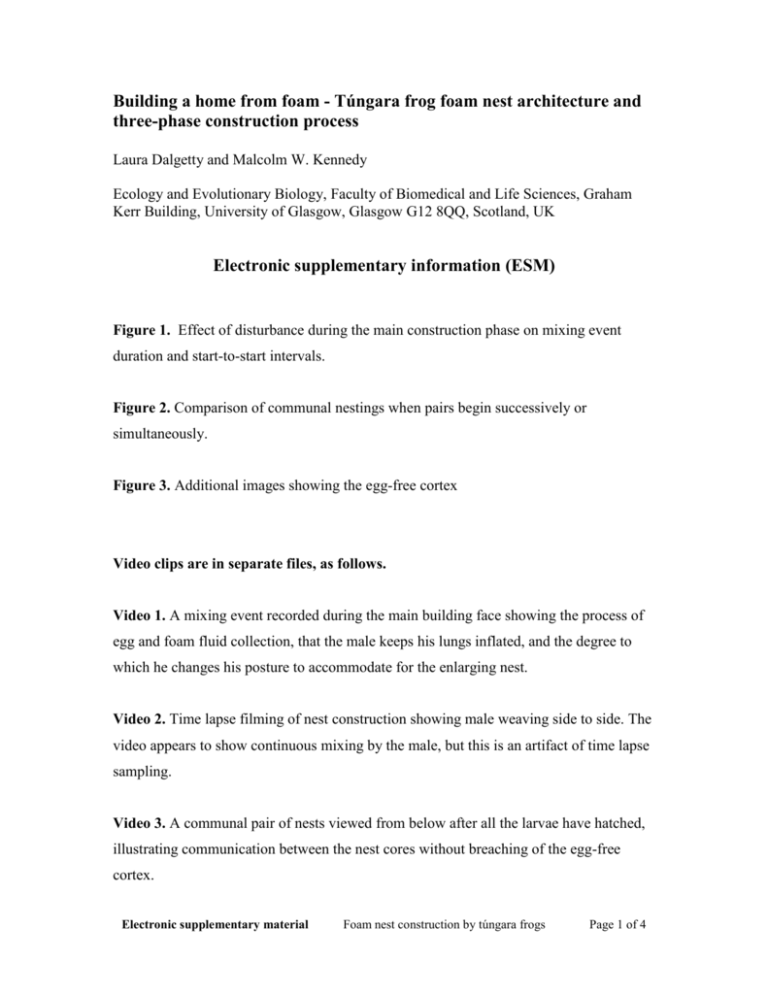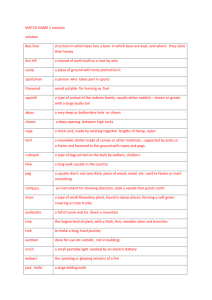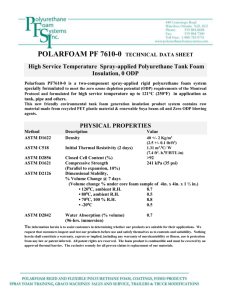Supplementary figures 1, 2 and 3
advertisement

Building a home from foam - Túngara frog foam nest architecture and three-phase construction process Laura Dalgetty and Malcolm W. Kennedy Ecology and Evolutionary Biology, Faculty of Biomedical and Life Sciences, Graham Kerr Building, University of Glasgow, Glasgow G12 8QQ, Scotland, UK Electronic supplementary information (ESM) Figure 1. Effect of disturbance during the main construction phase on mixing event duration and start-to-start intervals. Figure 2. Comparison of communal nestings when pairs begin successively or simultaneously. Figure 3. Additional images showing the egg-free cortex Video clips are in separate files, as follows. Video 1. A mixing event recorded during the main building face showing the process of egg and foam fluid collection, that the male keeps his lungs inflated, and the degree to which he changes his posture to accommodate for the enlarging nest. Video 2. Time lapse filming of nest construction showing male weaving side to side. The video appears to show continuous mixing by the male, but this is an artifact of time lapse sampling. Video 3. A communal pair of nests viewed from below after all the larvae have hatched, illustrating communication between the nest cores without breaching of the egg-free cortex. Electronic supplementary material Foam nest construction by túngara frogs Page 1 of 4 Start to start intervals (s) Duration of events (s) 5 A 4 3 2 1 200 180 160 140 120 B 100 20 0 0 50 100 150 200 250 300 Mixing event number Figure S1. Effect of disturbance on nesting. Durations (A) and intervals between starts (B) of mixing events throughout a single nesting in which the pair was disturbed by movement and lights in the laboratory at around mixing event number 195. In this case the pair did not leave the nest. Times expressed in seconds (s). Electronic supplementary material Foam nest construction by túngara frogs Page 2 of 4 350 Duration of mixing events (s) 5 A 4 3 2 1 0 0 20 40 60 80 100 120 Mixing event number 6 Duration of mixing events (s) B 5 4 3 2 1 0 0 50 100 150 200 250 Figure S2. Comparison of communal nestings when pairs begin successively or simultaneously. (A) Three pairs contributing to the same communal nest, but starting at different times, showing that the follower pairs (green then magenta) increase the duration of their mixings progressively more rapidly than did the pioneer pair (blue). (B) Two pairs producing a communal nest and beginning almost simultaneously exhibit similar progressive changes in the duration of their mixing events in phase 1. In both graphs the event numbers start at the first mixing by the pioneer pair. Times expressed in seconds (s). Electronic supplementary material Foam nest construction by túngara frogs Page 3 of 4 Figure S3. Egg-free cortex. A nest viewed at different orientations and lighting to show the egg-free cortex, eggs confined to the core of the nest, and an apparent discontinuity in the consistency of the foam at the core:cortex boundary. Electronic supplementary material Foam nest construction by túngara frogs Page 4 of 4








